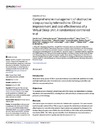Please use this identifier to cite or link to this item:
https://accedacris.ulpgc.es/jspui/handle/10553/70074
| DC Field | Value | Language |
|---|---|---|
| dc.contributor.author | Lugo, Vera M. | en_US |
| dc.contributor.author | Garmendia, Onintza | en_US |
| dc.contributor.author | Suarez-Girón, Monique | en_US |
| dc.contributor.author | Torres, Marta | en_US |
| dc.contributor.author | Vázquez Polo, Francisco José | en_US |
| dc.contributor.author | Negrín Hernández, Miguel Ángel | en_US |
| dc.contributor.author | Moraleda, Anabel | en_US |
| dc.contributor.author | Roman, Mariana | en_US |
| dc.contributor.author | Puig, Marta | en_US |
| dc.contributor.author | Ruiz, Concepcion | en_US |
| dc.contributor.author | Egea, Carlos | en_US |
| dc.contributor.author | Masa, Juan F. | en_US |
| dc.contributor.author | Farré, Ramon | en_US |
| dc.contributor.author | Montserrat, Josep M. | en_US |
| dc.date.accessioned | 2020-02-05T12:52:14Z | - |
| dc.date.available | 2020-02-05T12:52:14Z | - |
| dc.date.issued | 2019 | en_US |
| dc.identifier.issn | 1932-6203 | en_US |
| dc.identifier.other | Scopus | - |
| dc.identifier.uri | https://accedacris.ulpgc.es/handle/10553/70074 | - |
| dc.description.abstract | Introduction Obstructive sleep apnea (OSA) is a prevalent disease associated with significant morbidity and high healthcare costs. Information and communication technology could offer cost-effective management options. Objectives To evaluate an out-of-hospital Virtual Sleep Unit (VSU) based on telemedicine to manage all patients with suspected OSA, including those with and without continuous positive airway pressure (CPAP) therapy. Methods This was an open randomized controlled trial. Patients with suspected OSA were randomized to hospital routine (HR) or VSU groups to compare the clinical improvement and cost-effectiveness in a non-inferiority analysis. Improvement was assessed by changes in the Quebec Sleep Questionnaire (QSQ), EuroQol (EQ-5D and EQ-VAS), and Epworth Sleepiness Scale (ESS). The follow-up was 3 months. Cost-effectiveness was assessed by a Bayesian analysis based on quality-adjusted life-years (QALYs). Results The HR group (n: 92; 78% OSA, 57% CPAP) compared with the VSU group (n: 94; 83% OSA, 43% CPAP) showed: CPAP compliance was similar in both groups, the QSQ social interactions domain improved significantly more in the HR group whereas the EQ-VAS improved more in the VSU group. Total and OSA-related costs were lower in the VSU group than the HR. The Bayesian cost-effectiveness analysis showed that VSU was cost-effective for a wide range of willingness to pay for QALYs. Conclusions The VSU offered a cost-effective means of improving QALYs than HR. However, the assessment of its clinical improvement was influenced by the choice of the questionnaire; hence, additional measurements of clinical improvement are needed. Our findings indicate that VSU could help with the management of many patients, irrespective of CPAP use. | en_US |
| dc.language | eng | en_US |
| dc.relation | PI14/00416 | en_US |
| dc.relation | PI17/01068 | en_US |
| dc.relation | Catalan Society of Pneumology (SOCAP) | en_US |
| dc.relation.ispartof | PLoS ONE | en_US |
| dc.source | PLoS ONE [ISSN 1932-6203], v. 14 (10), e0224069 | en_US |
| dc.subject | 530202 Modelos econométricos | en_US |
| dc.subject.other | Apnea | en_US |
| dc.subject.other | Unidad del sueño | en_US |
| dc.subject.other | Tratamiento | en_US |
| dc.subject.other | Coste-beneficio | en_US |
| dc.subject.other | Métodos estadísticos | en_US |
| dc.title | Comprehensive management of obstructive sleep apnea by telemedicine: clinical improvement and cost-effectiveness of a virtual sleep unit. A randomized controlled trial | en_US |
| dc.type | info:eu-repo/semantics/article | en_US |
| dc.type | Article | en_US |
| dc.identifier.doi | 10.1371/journal.pone.0224069 | en_US |
| dc.identifier.scopus | 85074077574 | - |
| dc.contributor.authorscopusid | 57195298342 | - |
| dc.contributor.authorscopusid | 57192074799 | - |
| dc.contributor.authorscopusid | 57196279103 | - |
| dc.contributor.authorscopusid | 7402581378 | - |
| dc.contributor.authorscopusid | 6602318225 | - |
| dc.contributor.authorscopusid | 9249657200 | - |
| dc.contributor.authorscopusid | 57211470538 | - |
| dc.contributor.authorscopusid | 57211471513 | - |
| dc.contributor.authorscopusid | 57140045600 | - |
| dc.contributor.authorscopusid | 56799905600 | - |
| dc.contributor.authorscopusid | 56434552800 | - |
| dc.contributor.authorscopusid | 7003898125 | - |
| dc.contributor.authorscopusid | 7005762629 | - |
| dc.contributor.authorscopusid | 57205303920 | - |
| dc.identifier.issue | 10 | - |
| dc.relation.volume | 14 | en_US |
| dc.investigacion | Ciencias Sociales y Jurídicas | en_US |
| dc.type2 | Artículo | en_US |
| dc.utils.revision | Sí | en_US |
| dc.identifier.ulpgc | Sí | en_US |
| dc.contributor.buulpgc | BU-ECO | en_US |
| dc.description.sjr | 1,1 | |
| dc.description.jcr | 2,776 | |
| dc.description.sjrq | Q1 | |
| dc.description.jcrq | Q2 | |
| dc.description.scie | SCIE | |
| dc.description.erihplus | ERIH PLUS | |
| item.fulltext | Con texto completo | - |
| item.grantfulltext | open | - |
| crisitem.author.dept | GIR TIDES- Técnicas estadísticas bayesianas y de decisión en la economía y empresa | - |
| crisitem.author.dept | IU de Turismo y Desarrollo Económico Sostenible | - |
| crisitem.author.dept | Departamento de Métodos Cuantitativos en Economía y Gestión | - |
| crisitem.author.dept | GIR TIDES- Técnicas estadísticas bayesianas y de decisión en la economía y empresa | - |
| crisitem.author.dept | IU de Turismo y Desarrollo Económico Sostenible | - |
| crisitem.author.dept | Departamento de Métodos Cuantitativos en Economía y Gestión | - |
| crisitem.author.orcid | 0000-0002-0632-6138 | - |
| crisitem.author.orcid | 0000-0002-7074-6268 | - |
| crisitem.author.parentorg | IU de Turismo y Desarrollo Económico Sostenible | - |
| crisitem.author.parentorg | IU de Turismo y Desarrollo Económico Sostenible | - |
| crisitem.author.fullName | Vázquez Polo, Francisco José | - |
| crisitem.author.fullName | Negrín Hernández, Miguel Ángel | - |
| Appears in Collections: | Artículos | |
Items in accedaCRIS are protected by copyright, with all rights reserved, unless otherwise indicated.
